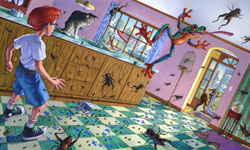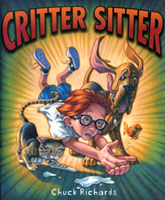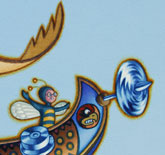AMES, Iowa -- Chuck Richards was well into his 40s when he found his calling as an artist. Now the Iowa State University associate professor is reaping the success of his newfound passion as a children's book author and illustrator.
Richards' book, "Critter Sitter," was published by Walker Books on Sept. 30, just as he delivered to the University of Iowa Children's Hospital the last of four commissioned paintings based on his earlier book, "Jungle Gym Jitters" (see sidebar). He will hold a book signing at the University Book Store in the ISU Memorial Union from 6 to 7 p.m. Wednesday, Dec. 3.
Although Richards says he feels like he's "hit his stride as an artist," he's not quitting his "day job" teaching drawing to all first-year students in ISU's College of Design.
"My teaching and studio practice mesh absolutely perfectly," Richards said. "Everything in my own work that I think is most important has to do with the fundamentals of drawing. And everything that I practice in my own work, I touch upon in my teaching to first-year students."

"Critter Sitter" features a pesky tree frog.
"Critter Sitter" is a 32-page book of whimsical, detailed color illustrations for children ages 4 to 8. It tells the story of Henry, a boy who starts a pet-sitting business. Henry's first customer entrusts him with a menagerie of unruly pets, including a tree frog and a bloodhound named Slobberchops. What ensues is a "comedy of terrors" in which one thing leads to another and everything goes wrong. Eventually, through a process of trial and error, Henry perseveres and all ends well.
The story is inspired by Richards' daughter's experience with pet sitting five years ago. While caring for a neighbor's dog and tree frog, the tree frog got loose.
"We were instructed to feed the tree frog daily by putting a live cricket into the frog's tank," Richards said, "While doing that, the frog escaped. It took an hour to finally get the frog back into the tank."
With their sticky feet, colorful markings and bright red eyes, tree frogs lend themselves to countless creative possibilities. At the urging of his family, Richards developed the tree frog/pet- sitting incident into a story outline and submitted it with three others to his editor.
"This one was her pick," he said.
That was in the spring of 2005. He completed the book three years later, working nights and weekends, and shuttling between the book and the mural-sized paintings for the hospital.
"If I didn't have a studio at home, my wife and kids would never see me," Richards said.
"I finally feel as though I've stumbled upon the thing that I was meant to do as an artist," Richards said. "I'm trying to take full advantage of the opportunity while I have it and do as much work as I can. But it doesn't seem like work -- I really like doing it."
After drafting the text, Richards spent many weeks on each illustration. He drew several rough sketches of each before selecting the best. Next, he collected images and photos of each animal in the story. Based on those, he drew simple forms that could be rotated in space and drawn from various angles. Then he drew rough thumbnail sketches of stick figures, which provided crude information about the "attitude of the animal" and the angle view of the illustration. He drew three or four versions of each illustration to have optional views from which to create an integrated flow from one page to the next.
"I drew what I saw in my imagination and informed that with research in the libraries and image searches so I could stage exactly what I wanted," he said.
"My thinking was very much like a filmmaker. I changed the perspectives from high to low and the view from close to far," Richards said. "I was always trying to place the viewer at the most dramatic spot in relationship to the scene to heighten the psychology of that moment."
Richards then developed the line drawings, which were separated into parts--the room and fixtures, and the characters on separate pieces of tracing paper. He scanned all of the elements and made composites in Photoshop. This allowed him to re-use the same room background in more than one illustration and redraw just the characters.
Next, Richards printed and transferred the drawings onto watercolor paper, which was stretched, soaked and shrunk tight. He finished the illustrations by applying color washes to the line drawings, then going over the surface with color pencil.
Now that it's published, Richards enjoys doing readings and book signings in schools.
"It's out of my hands, now. I've done everything I can to make the book as good as I could," he said. "Once it's published, it's out there. It's going to do what it's going to do. If it does well, great."


